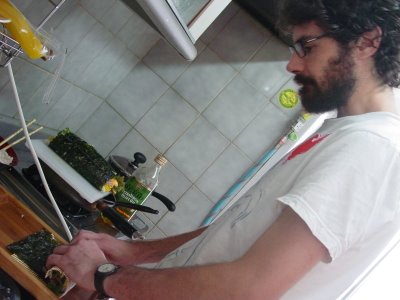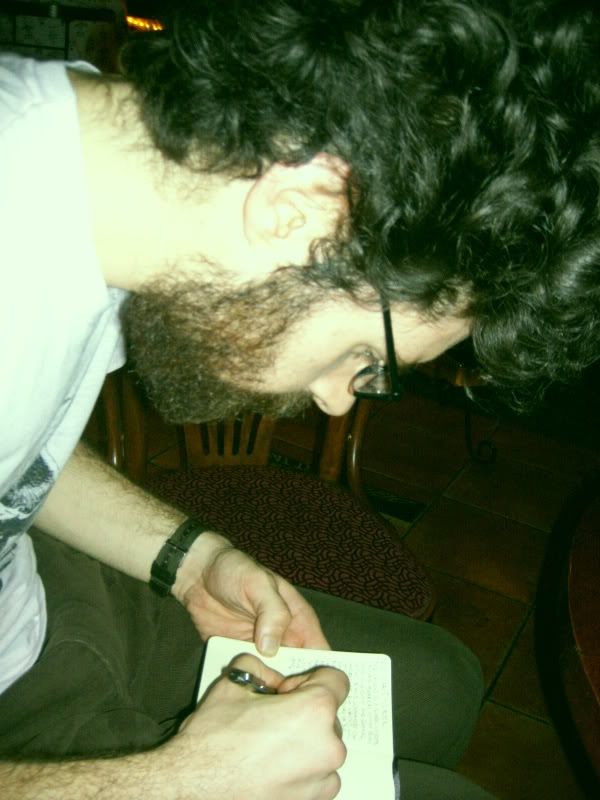We'll start with side dishes. You ALWAYS get kimchi with your meal. If you haven't heard about this delightful product, it is fermented cabbage that is literally doused in red chili paste. Tangy and spicy, to say the least. Secondly, you almost always get slices of yellow pickled radish. I'm talking the giant radish, that if you're familiar with it in Japanese food, you will know as daikon. This is salty, sweet and vinegary. Rounding out the list of ever-present side dishes is a weak soybean soup (you get this only if your meal isn't soup). However, there are probably hundreds of other side dishes that you may or may not receive, depending on the restaurant. Quite possibly my favorite is jon. This is a fried egg and/or flour pancake type object that has some sort of vegetable or octopus inside of it. It is always greasy, and usually delicious. Small servings of seaweed or mushroom salad are also quite popular and tasty. Radish kimchi is a regular on the table, taking many different forms and styles. One dish I'm quite fond of is what I think is sauteed spinach with garlic. Speaking of garlic, raw garlic is served on occasion as well. Some places (usually bars, I've found) serve an inexplicably burn-your-fucking-tongue-off spicy clear bean sprout soup. Be careful with this one; it may be the spiciest food product in Korea, and because it's not red, it'll sneak up on you and leave you crying, like the best friend who steals your girlfriend. There are definitely more side dishes to mention, but I think you get the point.
The most accessible food is at lunch/snack/all night restaurants that are kind of the Korean equivalent of fast food. Here, you can get quick, cheap food, but unlike American fast food, it is not greasy, meaty, fried, or cheesy. The main staple of this type of food is kimbap. This is rice rolled up in seaweed with goodies inside. It looks like sushi rolls, but doesn't have raw fish, crab or avocado inside. Inside kimbap, you'll find egg, ham, yellow radish, fish cake, inexplicable brown vegetable (I think I've determined that it is fern sprouts), and occasionally an extra item of your choice. My favorite is tuna (chamchi) kimbap. Another staple at these places is mandu, or dumplings. They are steamed, and filled with salty, meaty, vegi goodness. Bibimbap is quite possibly the food product that has most nourished me here. This is an excellent dish that is a big bowl of rice, topped off with fresh greens, seaweed, a healthy dollop of red pepper paste, and a fried egg. You can also get a number of noodle soups, like udong (Japanese style wide noodles) and spicy lamyeon (ramen). Tappap is a food of your choice (beef, kimchi, tuna, etc.) over a heaping helping of rice. Naengmeon is like cold slimy ramen that is impossible to bite through. It literally comes with scissors to cut the slimy mess hanging out of your mouth after a bite. Finally, you can even get a fried pork cutlet that comes with a fork and knife to eat it with. This is called dongasu.
(At this point, it is worth pointing out the eating utensils you are provided. Of course, you get chopsticks, but these are slippery, stainless steel chopsticks, not the forgiving wood or plastic type you are used to. Luckily, you also get a spoon, which you are encouraged to use for rice and dishes like bibimbap and tappap.)
Outside of these quick bite spots, restaurants usually focus on one or a few dishes. Soups are incredibly popular. Kimchi chigae is just like it sounds; spicy kimchi soup. The best place for kimchi chigae in Daejon (reputedly) is just down the street from my house/work, and their soup is made with kimchi that is aged for 3 years. It is almost indescribably sour, salty, spicy, and mouth wateringly delicious. Tang is another type of soup, usually one which comes with beef or ribs. A soup-type food dish is one that involves a boiling pot of broth at your table, in which you cook thin strips of meat, mushrooms, vegetables, etc. Ja jong myeon is udon-style noodles with a delectable black bean sauce. Bulgogi is very thin strips of marinated beef and vegetables. Kalbi is fatty, greasy barbeque pork. I wish I could remember the name of the bacon-like pork product you fry up at your table. I can't. But, imagine a thicker, fattier, greasier bacon, which fries right in front of you, while dousing the rest of your meal on the grill with delicious hog grease. It's even better than it sounds. Often with the meats, you take the cooked product and wrap it up in a leaf with raw garlic and a droplet of chili paste. One of the leaves you use is sesame leaf. I don't know why we don't have sesame leaves in the west. They are large, almost minty tasty and unbelievably fresh tasting.
The seafood in this country is absolutely out of control. With any luck, you've already seen the photos from the Pohang fish market. Octopus is everywhere, as are small dried fish. However, when our boss took us out for a seafood feast last week, I ate things I had never dreamed of. It's always good when you ask what something is, and the reply is that there is no English word for it. Quite possibly the best dish in terms of shock value was the raw octopus tentacles that had literally just been chopped off of the puss. They were wriggling around on the plate, and the suckers would definitely grip weakly to the inside of your mouth on the way down. Raw eel was served with with a spicy red sauce. There were several raw invertebrates that all taste kind of vaguely salty and chewy. You had some more standard raw sea products, such as oysters and tuna, but they were much fresher than any I've ever had. (These restaurants keep their product alive in tanks until you order it. (Well, not the tuna.)) I'm pretty sure it was conch that was a small shelled creature that you literally had to rip still living out of its shell. These tasted good, but I wasn't fond of ripping a living creature out of its home. I don't really know how to describe the several dishes that don't have English names. All I've mentioned so far are the side dishes, the main dish was a couple of platters of raw sashimi-style fish. At least 7 varieties of fish, mostly meaty white fish. The English names of the fish were unknown. These you would wrap up in the sesame or lettuce leaves, along with raw garlic, chili paste, and shoot it down. The meal was wrapped up with a literally fish-head soup that was not my favorite dish on the table.
I have two more items to tell you about before you're done with this bizarre rant. They are both extremely prevalent and strange. The first is dok. This is a gluttonous rice cake that can take many forms. It has roughly zero flavor, and is mostly characterized by its extremely chewy texture. It comes in a variety of types and styles, from a sweet-like snack, to a grilled hot dog like tube. The most common form is a street food called dok-bokki. This is heated dok in spicy sauce that you can get on just about every street corner. Dok is not bad, though some westerners (especially upon first taste) find it objectionable. The second item is odaeng. Odaeng is fishcake; basically ground fish (I'm under the impression that it's any generic fish) mixed with flour. This stuff is also on every street corner, in the form of long, wide strips on skewers. It also turns up in soups, side dishes, and your kimbap. It tastes just about as you would imagine it to, fishy.
I keep coming up with more to say, but I think I've given you enough examples for you to be impressed with the variety and flavor Korean cuisine.


